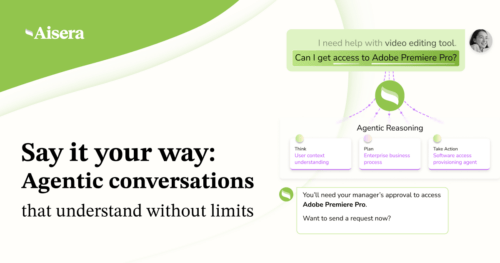Most of us have experienced the frustration of dealing with clunky robotic (and logic-driven) chatbots or support systems that just don’t understand you, and that you have to be very specific in how you ask it, and the way it can only understand you. You ask a question, and suddenly you’re clicking through menus, repeating yourself, or stuck in a loop that never really answers what you need. These systems were designed to target simple use cases, such as when people asked one question at a time, in a single channel, with no interruptions or side questions, as they followed a certain flow of logic in the background.
But today’s work environment is different. Employees constantly switch between tasks and devices, often mid-conversation, and expect answers that adapt to their dynamic work styles. At the same time, they bring consumer-grade expectations to the workplace, demanding the same seamless, personalized experiences they enjoy in their daily lives. The old model of intent-based AI and rigid workflows simply can’t keep up with the pace of modern business.
That’s why Aisera’s agentic conversations are a bold departure from the rigidity of deterministic conversational AI. Unlike traditional systems that depend on rigid intents, static flows, and scripted responses, agentic conversation is adaptive by design. It dynamically pursues user goals, adjusts to disambiguity in real time, and handles the complexity of real-world dialogue with actual intelligence.
Built into the Aisera Assistant, this capability transforms how enterprises engage users and resolve issues. More than just a chatbot or conversational layer, agentic conversations are autonomous, context-aware interactions that understand intent, retrieve answers, and complete complex tasks through multi-turn interactions — all in real time. This next-generation conversational capability drives faster resolutions, improved productivity, and dramatically better experiences across the organization. Below are the key capabilities that power agentic conversations:
Intentless understanding and contextual disambiguation

At the core of agentic conversations is intentless understanding, the ability to instantly grasp user requests in natural language, regardless of how they’re phrased. Traditional chatbots often stumble when users deviate from expected intents or ask questions that haven’t been pre-programmed. With Agentic Conversations, there’s no need for extensive setup or managing complex intent libraries, enabling faster AI deployment and immediate value across teams as the system naturally adapts to varied and unexpected queries.
Imagine an employee asking, “Can you help me reset my VPN?” or “I’m having trouble accessing the finance app.” Instead of relying on pre-defined intents like “VPN reset” or “finance app access,” agentic conversations instantly understands the query, retrieves relevant information, and delivers context-aware responses. This eliminates the bottlenecks of intent training, reduces complexity, and ensures that every interaction is frictionless and productive.
Also built into Aisera Assistant is contextual disambiguation capability. The system gains a deeper understanding of each query or ticket by analyzing context, multi-turn interactions, user behavior, and historical interactions. This means it can seamlessly handle side questions, interruptions, and follow-ups within a single interaction, delivering responses that are not just accurate but also relevant to the broader conversation. Imagine an employee troubleshooting a software issue who then asks, “Can you also help me with my VPN?”—Agentic Conversations keeps track of both the primary and secondary queries, ensuring they’re resolved effectively.
Multi-fulfillment
With agentic conversations, Aisera Assistant goes beyond just understanding natural human language and answering questions. It retrieves information from any knowledge source, public or private, and enables employees to trigger actions for end-to-end task completion. Picture an employee asking, “What’s the status of my IT ticket?” Traditionally, employees had to navigate multiple steps just to check the status of a ticket. If they were dissatisfied, they often had to initiate a separate request to escalate the issue, wasting time and adding frustration.
Without multi-fulfillment capabilities, employees must repeatedly break down natural requests into more straightforward, fragmented steps. This process not only frustrates users but also increases workload, introduces errors, and wastes valuable time.
With multi-fullment, Aisera Assistant not only provides the update but can also provide an option to escalate the ticket, assign it to an expert, or even close it, all within a single conversation. This seamless integration of answers and actions reduces errors, reduces manual overhead, saves time (user clicks), and improves productivity.
Multi-modality
Hybrid work has blurred the lines across multiple digital and voice channels, and employees expect their support experience to keep up. Agentic conversations enable multi-modal interactions, which means supporting a wide range of input types and communication channels, including voice, text, email, chat, and phone. Aisera Assistant unifies these interactions, maintaining conversation context, memory, and history across platforms. This creates a seamless and continuous experience for employees and customers alike, reducing repetition and enabling faster resolutions.
Conclusion
Aisera’s agentic conversations redefine what’s possible. By moving beyond rigid intent and static scripts, enterprises can now deliver intuitive, adaptive, and deeply personalized experiences across every interaction. Whether clarifying vague requests, executing multi-step workflows, or maintaining continuity across channels, Agentic AI empowers organizations to resolve issues faster and engage users more intelligently.
If you’d like to learn more about how agentic conversation can transform your business, sign up for an Agentic AI demo today


